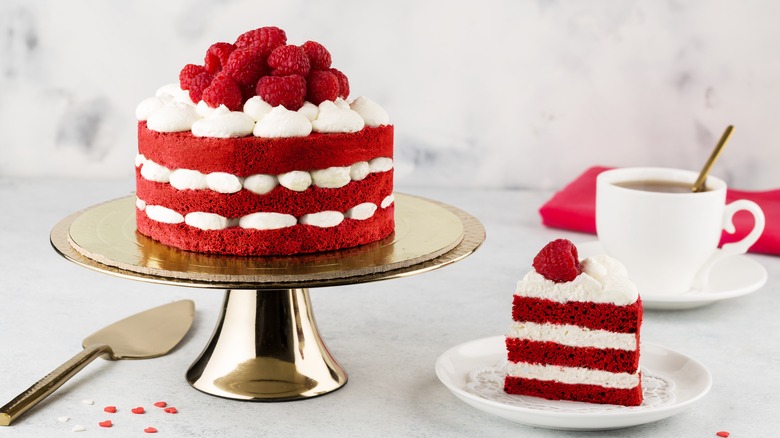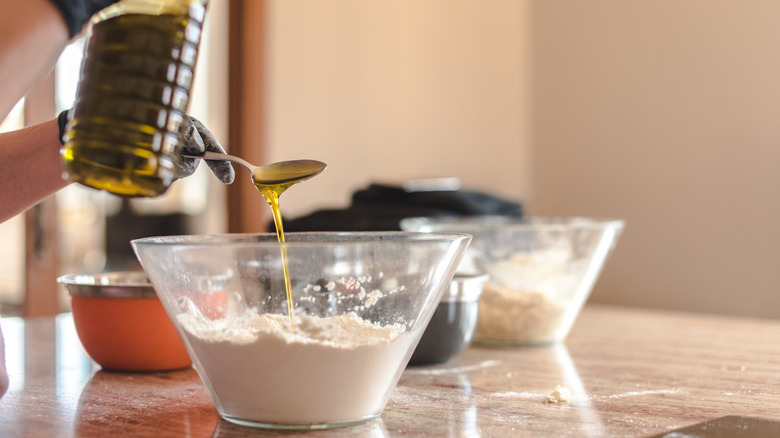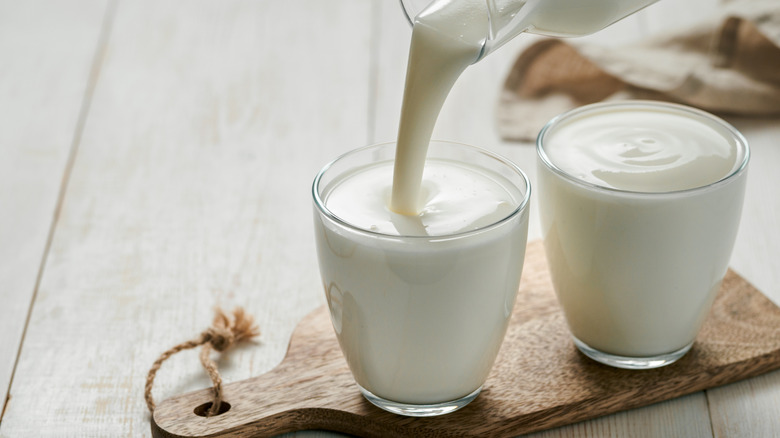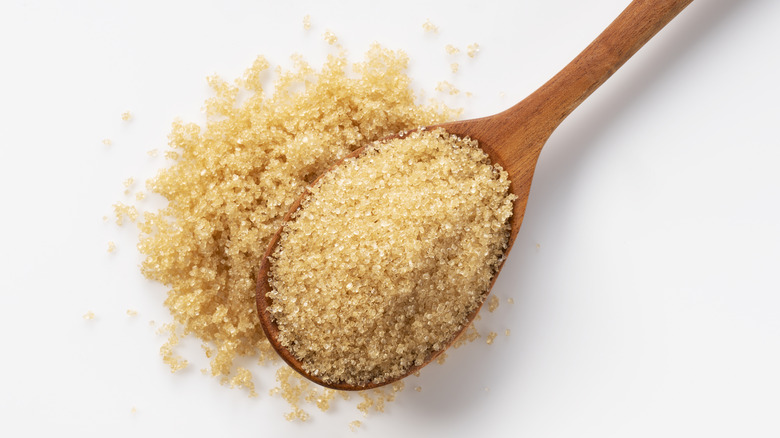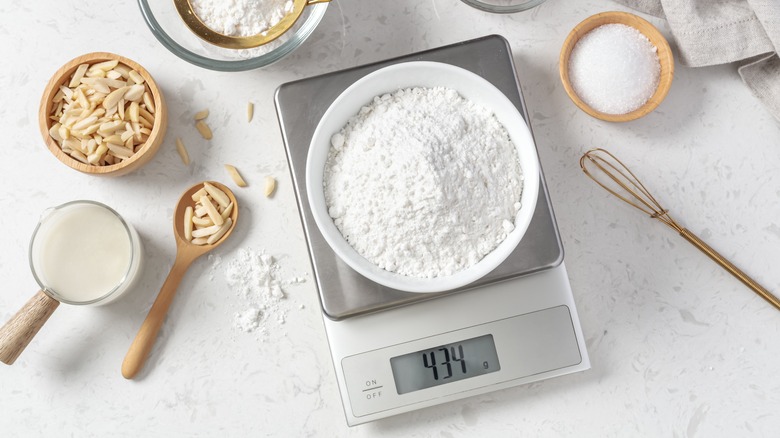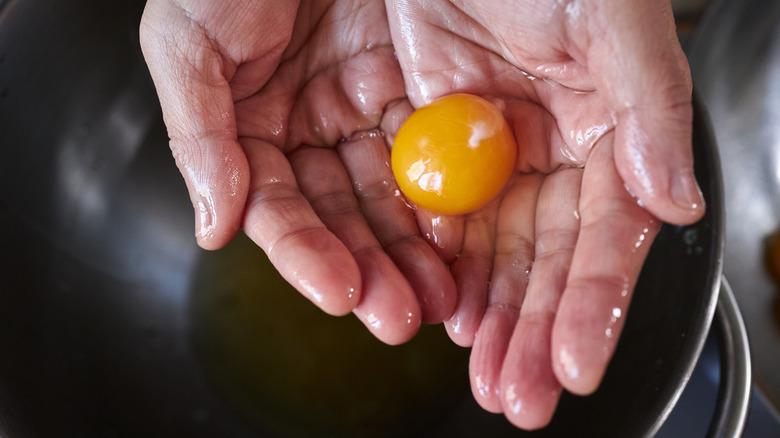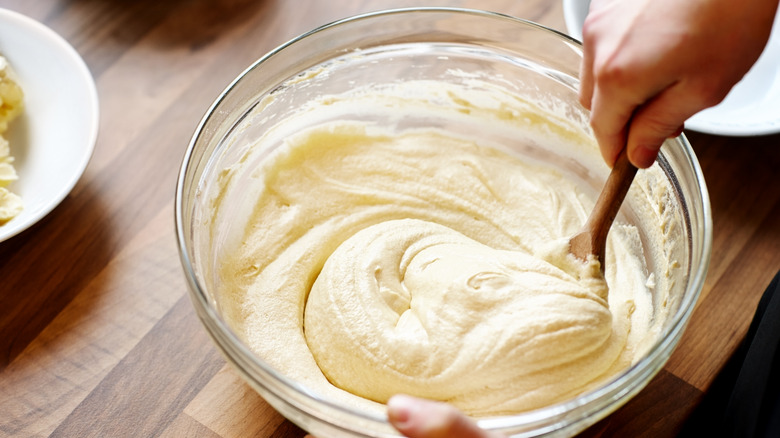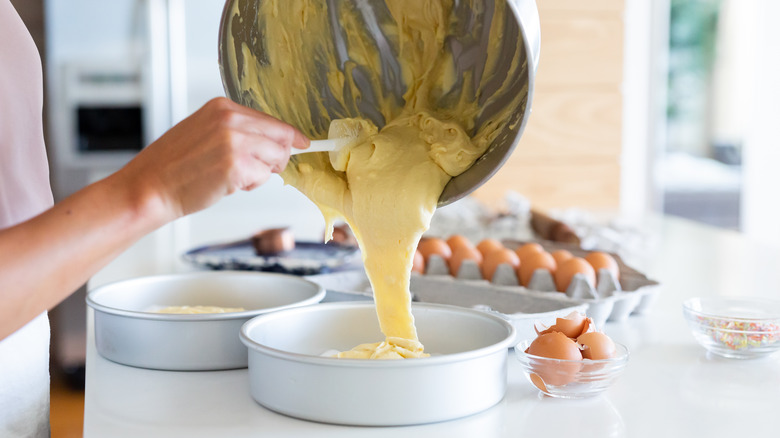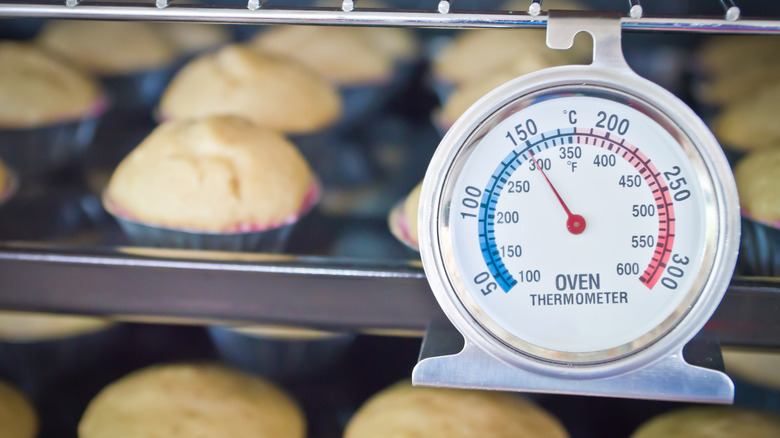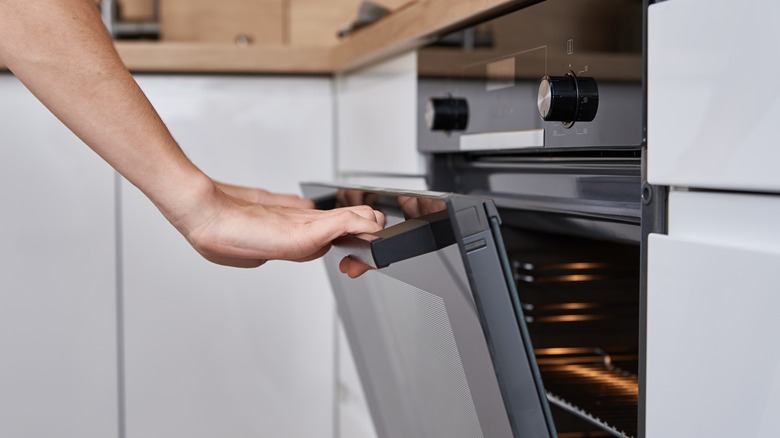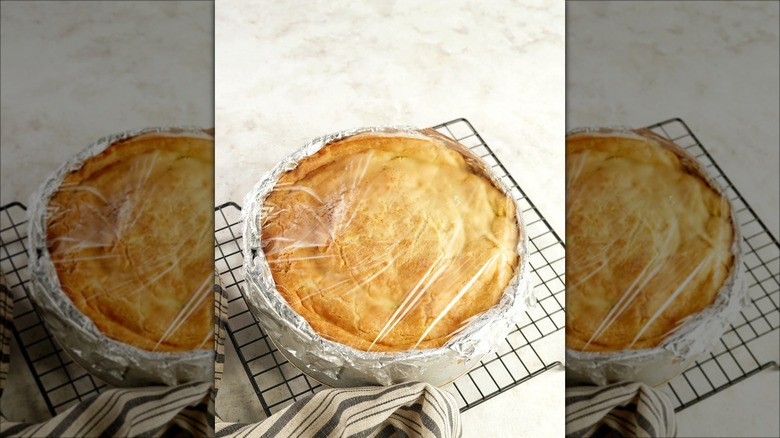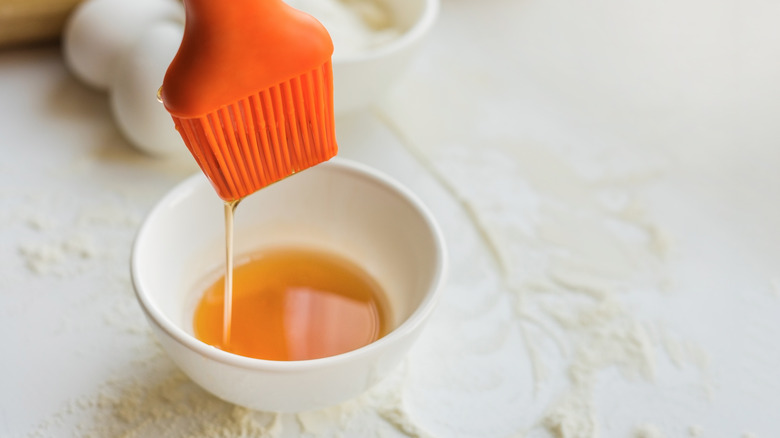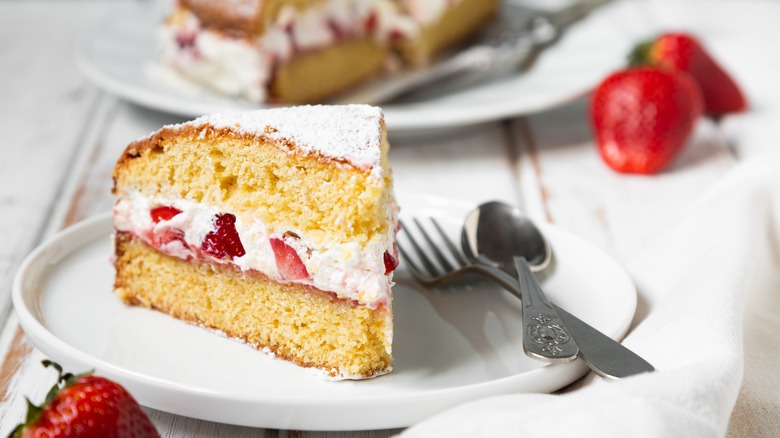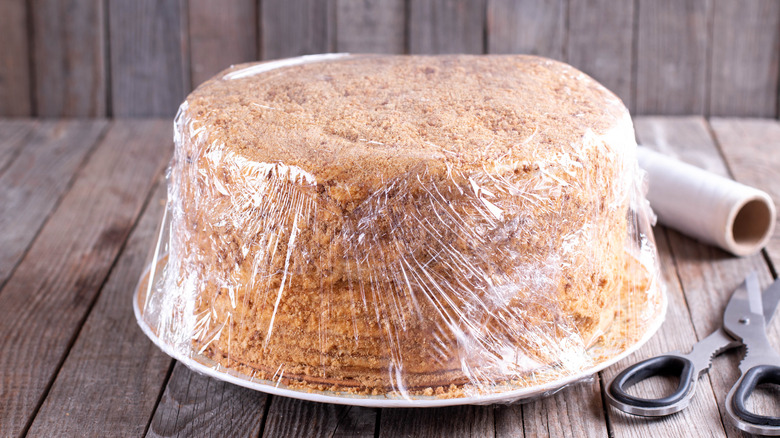14 Tricks For Keeping Your Cake Moist
Baking a cake can be a relaxing activity with a major payoff, but when things don't go as planned, it can ruin a perfectly good day. Take, for example, a dry cake. When you bite into a freshly baked Battenberg or Sachertorte only to discover that it's as parched as a crouton, you might be so upset that you swear off cake-baking altogether. As Ruby Bhogal, a finalist on the 2018 season of the Great British Baking Show and food writer for British GQ, put it, "[A] dry cake which takes a gallon of water to wash down is a sad, sad affair." Luckily, however, she has tricks you can employ to nail a perfectly moist cake texture every time.
Laura Kasavan, the food photographer and recipe developer behind the website Tutti Dolci, said that certain cakes run a greater risk of being dry, especially chocolate and coffee-flavored cakes. "Bundt cakes also run the risk of being dry from the dense batter and longer baking time," she said, adding that delicate cakes containing little to no fat, such as angel food cakes and sponge cakes, also tend to be dryer than others.
The formula for attaining a lusciously hydrated crumb is not rocket science, though Bhogal urged us to remember that baking is just as much chemistry as art. Keep reading to discover the simple tricks she and Kasavan swear by to make crouton cakes a thing of the past.
Choose your recipe carefully
For Ruby Bhogal, mastering a moist cake starts with picking a good recipe. For her Instagram series "Around the World in 80 Cakes," she's had to sift through countless online recipes to find the best and said that it all comes down to diligence. "At the end of the day, you are investing your time and money into making something hopefully delicious," she said. "So always [use] trusted sources for your recipes."
Experience pays off when you're choosing an online source as you are more likely to spot inexplicable ingredient ratios or overly long baking times. But Bhogal said that the ratings are another reliable way to determine whether a recipe is worth making. If hundreds of people have given it four or five stars, it's probably safe to rely on. Above all, she advised, "Proceed with caution if you are using an unknown recipe and always always always check the comments to see if anyone else [has] come across any problems."
Use oil instead of butter
Butter is the gold standard for baking. It creates a light, soft texture and adds a succulent flavor. When it comes to maximizing moisture in your cake, however, there is a better ingredient to rely on: vegetable oil. It may not provide the flavor, silkiness, or street cred of butter, but it makes up for these deficits with moisture.
At around 80% milkfat, butter is less fatty than oil. The remaining 20% is a combination of milk solids and water. This is preferable when making a sturdier cake because the water aids gluten activation and therefore creates a more durable structure. But if you want a soft, delicate cake, oil is preferable as it inhibits gluten production. The resulting cake will be tender and light rather than sturdy. Oil won't add liquid the way extra milk or an additional egg yolk will, but by improving the texture, it will help prevent toughness, which contributes to the overall impression of dryness. For best results, choose canola oil for its neutral flavor.
Use buttermilk instead of milk
One of Laura Kasavan's favorite tricks for keeping cakes moist is to simply swap buttermilk for milk. Buttermilk is an undervalued ingredient that is frequently replaced with more common acidic liquids such as yogurt or kefir but if you bake frequently, it's a good idea to keep some in your fridge at all times.
Like yogurt, buttermilk is a type of fermented milk, but it has a unique effect on baked goods due to its relatively low levels of protein and lactose and high level of acid. As Kasavan explained, "Acidity from the buttermilk activates the leavening agents (baking powder and baking soda) and helps break down gluten for an incredibly tender cake." Replacing milk with buttermilk doesn't increase the amount of liquid in your cake, but it does soften the texture. Increasing the amount of milk in the recipe might seem like a better idea, but if you add an extra quarter cup of it, you are more likely to end up with a dense, gummy cake than a light, moist one. Swapping the prescribed amount of milk with buttermilk will yield more desirable results.
Choose brown sugar
Brown sugar provides acidity, color, and a caramel flavor to baked goods, but it can also be a great way to combat dryness. While white sugar creates the crispy texture of cookies and contributes to the light, airy texture of cake, brown sugar produces a darker color, more intense flavor, and added moisture due to its molasses content. Molasses is a hygroscopic ingredient, meaning it absorbs moisture from the air. This is why it often clumps up and hardens when left in an unsealed bag, and why it makes it the perfect ingredient for keeping cakes the tiniest bit moister after they've been baked.
Brown sugar is one of the best places to start when you want to avoid a dry cake because, like oil and buttermilk, it won't backfire. Adding more liquid could add too much moisture, leaving you with a soggy, stodgy texture. Brown sugar adds a subtle hint of moisture and a deeper flavor without overloading the cake with liquid. For chocolate and coffee-flavored cakes, it also adds a rich, warm flavor that complements the other ingredients.
Treat it like a science
For many of us, a kitchen is a place of creativity; however, as Ruby Bhogal pointed out, "The thing about baking and in particular, cake making, is that it is a science." When attempting to make a moist cake, taking the time to be precise will always pay off. For Bhogal, this means using a scale to weigh your ingredients instead of using measuring cups and reading the recipe all the way through at least twice. "That is one thing I will forever be grateful to Bake Off for," she revealed, "I will ALWAYS read a recipe and method through at least twice before I do anything so I can a) get my head around the pending chaos and b) spot any glaring issues."
One of the harbingers of dryness is stiff batter. "If the batter feels too stiff and requires you to scoop the batter into the tin as opposed to [pouring], you may want to loosen it slightly with a few [tablespoons] of milk or oil," Bhogal said. As a rule of thumb, she suggests you always start with a small amount of liquid and work up from there if necessary.
Add an egg yolk
Another way to incorporate moisture into your cake is to add an extra yolk. Whole eggs are one of the most important ingredients in cakes because they provide structure, fat, and emulsification. Egg whites act as leavening agents because they can maintain a sturdy matrix of air bubbles when beaten, while yolks contain lecithin that emulsifies the fat and water content in the other ingredients. The yolk's ability to bind water and fat means that the batter can absorb more liquid, which leads to a moister cake.
Laura Kasavan suggested adding an extra yolk to cake batter due to its emulsifying capabilities, explaining that the added fat also produces a richer texture and helps the ingredients blend more easily. She explained that an extra yolk can be of particular benefit to chocolate cakes because cocoa powder is drying. If you like your cakes to be on the rich, moist side of the spectrum, an extra yolk is probably a better fit than replacing milk with buttermilk or using oil instead of butter, as these substitutions will create a lighter texture rather than a rich one.
Don't over-mix the batter
Over-mixing cake batter is one of those baking taboos that is often cited in recipes but is difficult to avoid without under-mixing. Ruby Bhogal acknowledged that the direction to mix the ingredients without over-mixing them can seem contradictory. "I agree it makes zero sense logically," she said. "[B]ut what [over-mixing] does is cause too much gluten to form which will then lead to a tough, dry crumb." She recommended stopping your mixer as soon as streaks of dry flour are gone, even when you still see small specks of it. "Remember that even by pouring into tins, you are still working the batter slightly, and you can mix these in when you are leveling the tops before it goes in to bake," she said.
Laura Kasavan said that one of the keys to avoiding over and under-mixing is to bring the ingredients to room temperature before starting the recipe. "Room temperature ingredients incorporate much more easily, creating a smooth and uniform batter," she explained. To speed up the warming process, she suggested slicing the butter into small cubes and putting the uncracked eggs in a bowl of warm water.
Opt for light-colored tins
The color of your cake tins has a surprising effect on the outcome of the cake. Like asphalt, dark metal absorbs heat more readily, meaning that your cake might end up with burned edges and an overbaked middle. You could cut your baking time by 10 minutes and enjoy eating the cake a few minutes earlier than expected, but baking faster is not necessarily a good thing, even when you're in a hurry. If the edges bake too quickly, they will block the heat from reaching the middle. As the edges begin to burn, the middle of your cake will still be liquid, and you'll be forced to choose between a gooey center with cooked edges or burned edges with a cooked center.
Laura Kasavan recommended using light-colored tins to avoid this problem. They absorb heat more slowly and will allow the heat to distribute evenly. Save dark pans for foods that are supposed to have a crispier crust, such as pies and pizzas.
Use an oven thermometer
Everyone knows they should avoid over-baking their cakes, but it isn't as easy as it sounds. You can follow the instructions to the decimal point only to find that your cake has burned edges and a dry, crumbly center. If this happens to you frequently, even though your oven is set at the proper temperature and you follow the prescribed timings, Laura Kasavan suggested getting an oven thermometer. "If you notice that your cakes are often dry, your oven may run hot," she said.
Temperatures vary greatly from oven to oven. If yours is small or uses gas instead of electricity, it will bake things faster. If it's calibrated improperly, it will also bake at a different rate. Even individual ovens fluctuate — instead of maintaining a constant temperature, they heat in cycles, bringing the temperature 10 degrees or more above the target, then letting it cool to slightly below the target. There are even areas within each oven that are hotter and cooler.
Kasavan suggests getting an oven thermometer to make sure the temperature is exactly what you're aiming for. That way, you can recalibrate the temperature to the thermometer rather than the oven's display panel and ascertain the temperature in the exact part of the oven where your cakes are baking.
Bake low and slow
According to Ruby Bhogal, one of the best ways to avoid drying out your cakes is to lower the heat of your oven. "When I am following a recipe I have found online, I always take the safe route of choosing to bake the sponge at a slightly lower temperature than stated, just so I have some control over the bake." She continued, "There have been many times when testing recipes for my online series where my bake times have wildly differed to what has been stated." In many cases, 325 degrees Fahrenheit is the sweet spot. It ensures a low, even bake that won't produce burned edges or a blink-and-you'll-miss-it moment between an under-baked and an over-baked cake.
Baking at a lower temperature has a slew of other benefits. It slows the leavening process, preventing the center of the cake from springing into a dome and making it hard to stack when you're assembling a layer cake. It also ensures an even texture: No dark, crispy edges and dense, gooey centers. An even texture allows for even greater moisture because it's more porous, meaning that if you brush the top with sugar syrup, it will seep deep into the cake rather than sitting on the impenetrable, over-baked crust. You'll need extra baking time, but as long as you check the center with a toothpick periodically, your cakes will be baked to perfection.
Wrap the cakes in plastic before they're done cooling
If you want to maximize moisture in your cakes, cover them shortly after you remove them from the oven. This goes against the common instruction to cool your baked goods completely before storing or decorating them, but it's a rule worth breaking. When you pull a cake out of the oven, it is still hot enough to lose moisture through evaporation. As it cools, the moisture turns from steam to liquid again, but not before much of it has been lost.
Recipes that direct bakers to let cakes cool completely before storing are essentially worried that trapping the steam will make them soggy. In reality, however, this is not a concern unless the cake is full of moisture-rich ingredients like fruit. Covering cakes when they come out of the oven is a great way to retain moisture and keep their delicate texture. Ruby Bhogal suggests waiting five minutes before turning the cakes out of their tins so they can absorb the residual heat and allowing them to cool for another 10 minutes on a baking rack. "Next, you want to wrap the sponges individually in clingfilm/saran wrap," she advised. "Yes, they will be warm but trust me, this step here will lock in all that moisture into your sponges and prevent them from drying out."
Brush or spray them with sugar syrup
Another way to lock in moisture is to brush the cakes with sugar syrup. Laura Kasavan recommended waiting until they have cooled before doing so to avoid an overly moist cake. If you brushed the syrup on while the cakes are still hot, you would not only be adding moisture from the syrup, but sealing in the internal moisture before it can evaporate. As you've probably gathered, crafting a perfectly moist cake is a delicate balancing act. A 1-to-1 ratio of sugar to water will produce a thin syrup that is neither watery nor thick. Simply bring it to a boil while your cake bakes and let it simmer for a few minutes until the sugar dissolves.
Ruby Bhogal also sings the praises of sugar syrup and called it a "simple solution to reviving even the driest of cakes." She also touted it as a great way to add flavor. "That water could be made up of orange juice, a bit of booze if that's your jam, spiked with a bit of zest, herbs or spice," she said. For best results, she recommended practicing extreme self-control by leaving your cake untouched overnight to fully absorb the liquid. Make sure to adjust the sugar content in your recipe to accommodate the added sweetness from the syrup.
Choose a moist filling
Like simple syrup, a water-rich filling will inject extra moisture from the outside in. Normally, most of us want to prevent icing from bleeding into the texture of our cakes, but when it comes to preventing dryness, a runny filling can be your secret weapon. This is especially the case when you only discover that your cake is dry after it's baked. You can't retroactively add an egg yolk or bake it at a lower temperature, but you can slice it in half and fill it with something runny.
To turn your dry cake into a moist one, you can either choose a filling that is moisture-rich or high in fat, depending on the type of cake and your personal preferences. Plain white or vanilla cakes go well with lemon curd, jam, and berry compote, while flavored cakes, such as chocolate or coffee, pair well with virtually nothing but whipped cream. Under-whipping the cream will allow the cake to absorb some of the liquid and become moister. If you're still worried about dryness, you can double up on the moisture by brushing the top with simple syrup.
Use proper storage techniques
Baking a cake perfectly does not guarantee it will still be moist the next day. You can have the lightest, most delicate texture when you pull it from the oven, only to discover 24 hours later that it's dry and chewy. To prevent this issue without resorting to eating the entire cake in less than a day — though there's no shame in that method — you need to focus on the post-baking phase as much as the measuring, mixing, and baking.
"Baked cakes dry out very quickly at room temperature," said Laura Kasavan, explaining that unfrosted cakes should be stored in plastic wrap if kept at room temperature, and two layers of plastic wrap if kept in the fridge.
Storing frosted cakes is slightly different. Kasavan recommended refrigerating them uncovered for 30 to 40 minutes first. "Once the frosting is firm, loosely wrap the cake in plastic wrap," she advised. "If you have space in your refrigerator, store the wrapped cake in a cake keeper for several days to prevent it from drying out in the fridge. Bring the chilled cake to room temperature at least 30 minutes before serving for the best texture. Once a cake is sliced, press plastic wrap directly against the sliced surface to prevent the leftovers from drying out."
